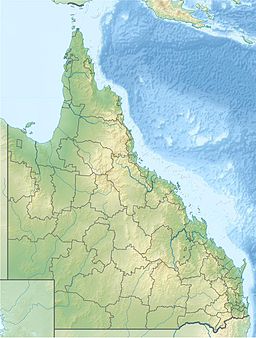Blue Lake is a lake located on North Stradbroke Island in the Australian state of Queensland about 44 kilometres (27 mi) east of the state capital of Brisbane.[citation needed]
| Blue Lake | |
|---|---|
| Karboora | |
 The undeveloped shores surrounding the lake are very natural | |
| Location | North Stradbroke Island, Queensland |
| Coordinates | 27°31′51″S 153°28′36″E / 27.5309°S 153.4768°E |
| Type | Window lake |
| Basin countries | Australia |
| Surface area | 7.3 ha (18 acres) |
| Max. depth | 9.4 m (31 ft) |
The lake which is known as a "window lake"[1] and is just under 10 metres (33 ft) deep when full. Water from the lake overflows into the Eighteen Mile Swamp. The aboriginal name for Blue Lake is Karboora.
Environmental studies have revealed the lake has been uniquely stable for thousands of years.[2] Blue Lake was the focus for research on environmental change in which numerous indicators such as water discharge, water quality, pollen and algae samples were examined to understand the history of the lake.
The lake is home to the Ornate_rainbowfish also known as the soft spined sunfish[3][4]
In 1980, the lake was described in the entry on the now-defunct Register of the National Estate for the Blue Lake National Park as follows:[5]
Blue Lake is a watertable lake in the coastal sandmass of North Stradbroke Island.
Although only relatively small, Blue Lake contains a diversity of habitats & species, including: Blue Lake, a boomerang-shaped watertable window lake; Tortoise Lagoon, a perched lake receding to swamp that fluctuates between swamp and a lagoon depending on rainfall; and other swamps; examples of dry sclerophyll forest, scrub heath, marshes, herbfields, associated linear swamps with surrounding eucalypt open forest and mallee heath. Such a wide range of features represents a large diversity of habitats.
The eastern tip of Blue Lake lies 1.75km from the ocean at which point a white-sandy bottomed, fast flowing creek with steep fern covered banks, carries the Blue Lake overflow down to Eighteen Mile Swamp. Two creeks that flow permanently, and a swamp, drain into the lake. The deepest parts of the lake reach around 11m in depth.
Two crustacean species, three fresh water fish, one frog species, 12 insect species and one spider were found in the littoral of Blue Lake. Most of the littoral and planktonic insects found in Blue Lake are common and widespread throughout Australia.
References
edit- ^ Hydrology of North Stradbroke Island Archived 4 July 2009 at the Wayback Machine, March 2006, (accessed 16 September 2009)
- ^ Margaret Scheikowski (4 June 2013). "Qld lake found to be 'climate refuge'". The Australian. News Limited. Retrieved 4 June 2013.
- ^ Atlas of Living Australia. "Species: Rhadinocentrus ornatus (Ornate Rainbowfish)". Atlas of Living Australia. Retrieved 17 May 2024.
- ^ "Australian Faunal Directory". Vascular Plants APC. 18 August 2021. Retrieved 17 May 2024.
- ^ "Blue Lake National Park, Tazi Rd, Dunwich, QLD, Australia - listing on the now-defunct Register of the National Estate (Place ID 8650)". Australian Heritage Database. Australian Government. 21 October 1980. Retrieved 23 October 2019.
Attribution
edit- This article incorporates text by Commonwealth of Australia available under the CC BY 3.0 AU licence.
